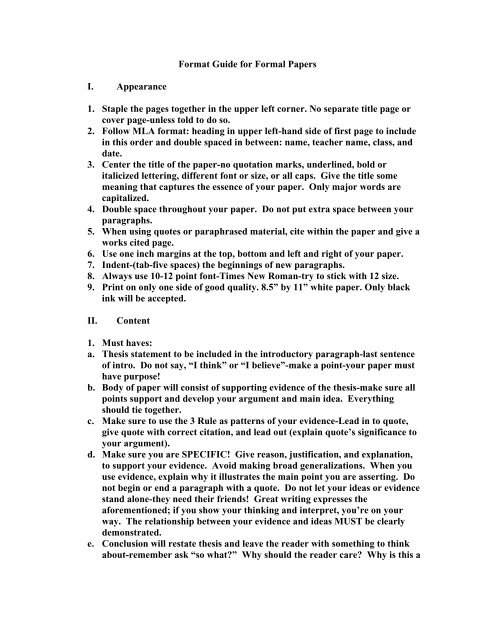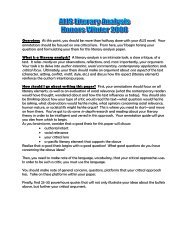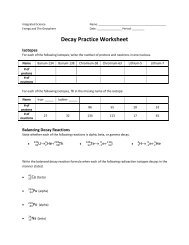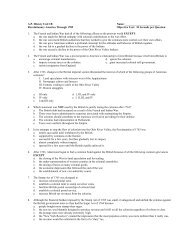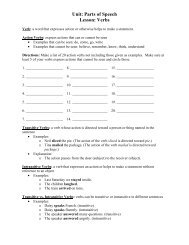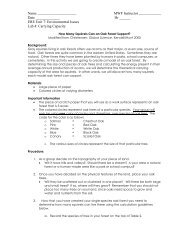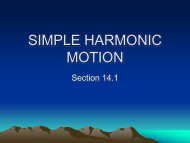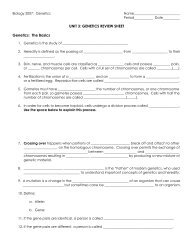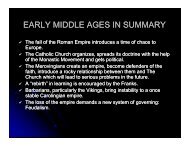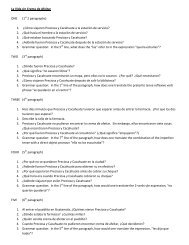Format Guide for Formal Papers I. Appearance 1. Staple the pages ...
Format Guide for Formal Papers I. Appearance 1. Staple the pages ...
Format Guide for Formal Papers I. Appearance 1. Staple the pages ...
Create successful ePaper yourself
Turn your PDF publications into a flip-book with our unique Google optimized e-Paper software.
<strong>Format</strong> <strong>Guide</strong> <strong>for</strong> <strong>Formal</strong> <strong>Papers</strong>I. <strong>Appearance</strong><strong>1.</strong> <strong>Staple</strong> <strong>the</strong> <strong>pages</strong> toge<strong>the</strong>r in <strong>the</strong> upper left corner. No separate title page orcover page-unless told to do so.2. Follow MLA <strong>for</strong>mat: heading in upper left-hand side of first page to includein this order and double spaced in between: name, teacher name, class, anddate.3. Center <strong>the</strong> title of <strong>the</strong> paper-no quotation marks, underlined, bold oritalicized lettering, different font or size, or all caps. Give <strong>the</strong> title somemeaning that captures <strong>the</strong> essence of your paper. Only major words arecapitalized.4. Double space throughout your paper. Do not put extra space between yourparagraphs.5. When using quotes or paraphrased material, cite within <strong>the</strong> paper and give aworks cited page.6. Use one inch margins at <strong>the</strong> top, bottom and left and right of your paper.7. Indent-(tab-five spaces) <strong>the</strong> beginnings of new paragraphs.8. Always use 10-12 point font-Times New Roman-try to stick with 12 size.9. Print on only one side of good quality. 8.5” by 11” white paper. Only blackink will be accepted.II.Content<strong>1.</strong> Must haves:a. Thesis statement to be included in <strong>the</strong> introductory paragraph-last sentenceof intro. Do not say, “I think” or “I believe”-make a point-your paper musthave purpose!b. Body of paper will consist of supporting evidence of <strong>the</strong> <strong>the</strong>sis-make sure allpoints support and develop your argument and main idea. Everythingshould tie toge<strong>the</strong>r.c. Make sure to use <strong>the</strong> 3 Rule as patterns of your evidence-Lead in to quote,give quote with correct citation, and lead out (explain quote’s significance toyour argument).d. Make sure you are SPECIFIC! Give reason, justification, and explanation,to support your evidence. Avoid making broad generalizations. When youuse evidence, explain why it illustrates <strong>the</strong> main point you are asserting. Donot begin or end a paragraph with a quote. Do not let your ideas or evidencestand alone-<strong>the</strong>y need <strong>the</strong>ir friends! Great writing expresses <strong>the</strong>a<strong>for</strong>ementioned; if you show your thinking and interpret, you’re on yourway. The relationship between your evidence and ideas MUST be clearlydemonstrated.e. Conclusion will restate <strong>the</strong>sis and leave <strong>the</strong> reader with something to thinkabout-remember ask “so what?” Why should <strong>the</strong> reader care? Why is this a
topic that remains controversial? How should <strong>the</strong> reader think about ittoday? Give universal insight and thought.f. Do not use in<strong>for</strong>mation in your paper that you don’t cite in works cited;conversely, make sure if you cite a source in <strong>the</strong> works cited, you must use itin your paper with correct in-text documentation.III. Style<strong>1.</strong> <strong>Formal</strong> essays should avoid using first and second person pronouns-No, “Ithink, I feel, in my opinion”, or any your or your, or we, our, us.2. Watch spelling errors. There should be no excuse <strong>for</strong> <strong>the</strong>se in your paper.Do not rely solely on spell or grammar check. Proofread your papers.3. Watch usage errors-use <strong>the</strong> right word in <strong>the</strong> context of <strong>the</strong> sentence.4. Pay attention to using correct capitalization, punctuation and apostrophes.5. Always try to write in active voice. An action verb is always superior to aboring “to be” verb. Am, is, was, are, were, be, being, been, has, had, have,get.6. Vary sentence structure and length to improve style. Also, vary sentencebeginnings. Watch those tedious run-ons (especially comma splices) andfragments.7. Use strong transitions to move between paragraphs and ideas.8. Utilize strong diction (word choice)-choose strong words! Use that<strong>the</strong>saurus. Be precise with your language.9. Never use slang, colloquial expressions or clichés.10. Use consistent tenseSuggestions <strong>for</strong> Editing• Read your paper out loud to yourself-you may catch errors by hearing if youare using language correctly-does it sounds right?• Look <strong>for</strong> fragments and run-ons (this includes comma splices).• Look <strong>for</strong> mistakes you know you commonly make.• Note how many times your repeat <strong>the</strong> same idea. Eliminate extra sentencesor “fluff”. Watch redundancy.• Check on your transitions. Make sure you have moved <strong>the</strong> reader to <strong>the</strong> nextidea.• First, look only <strong>for</strong> content errors (content is <strong>the</strong> WHAT of your paper-<strong>the</strong>meat). Then, look <strong>for</strong> style errors (style is <strong>the</strong> how you say it). Don’toverwhelm yourself. Take it one step at a time. Make sure you proofreadyour paper multiple times. Editing your paper over and over will make youa better writer because you are more apt to recognize errors. Don’t be lazy!


